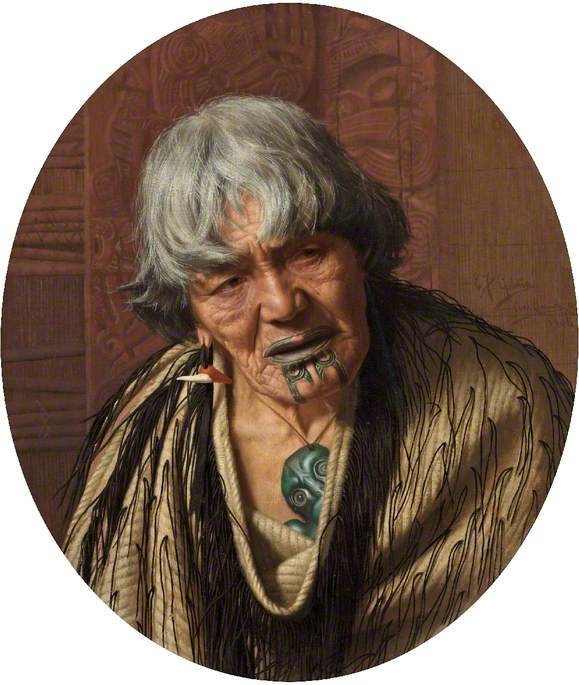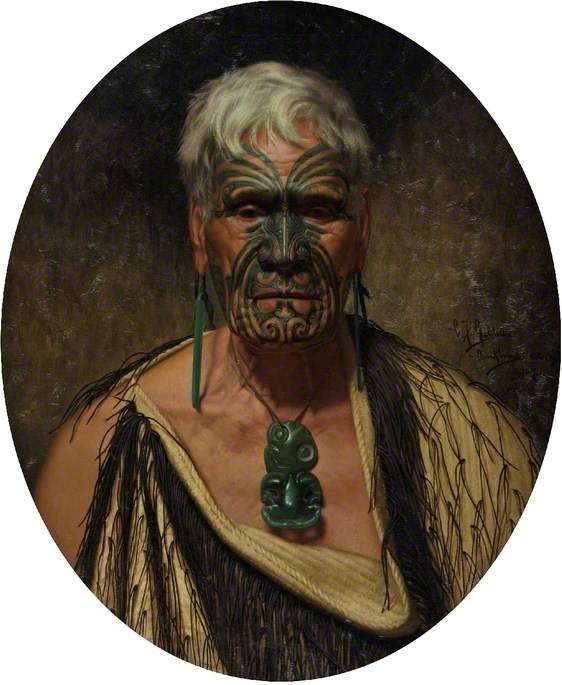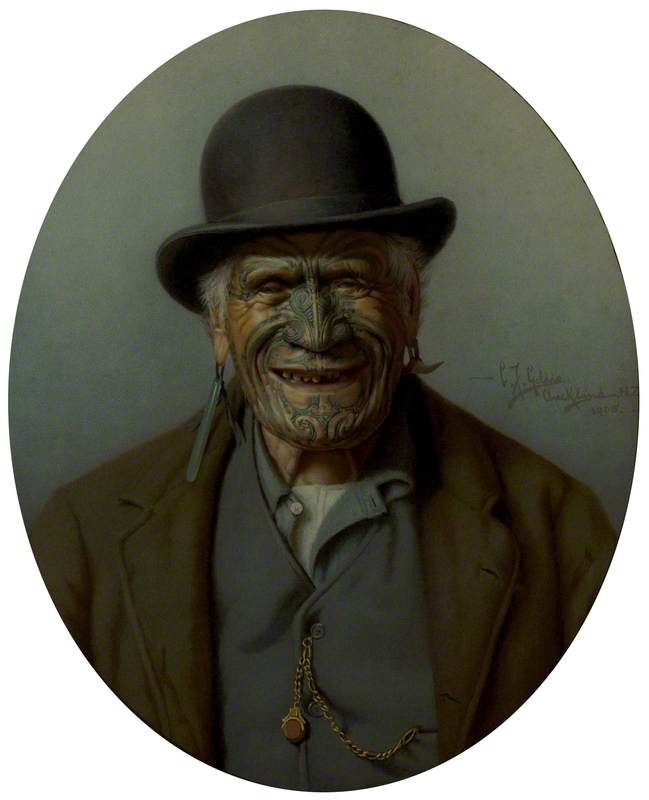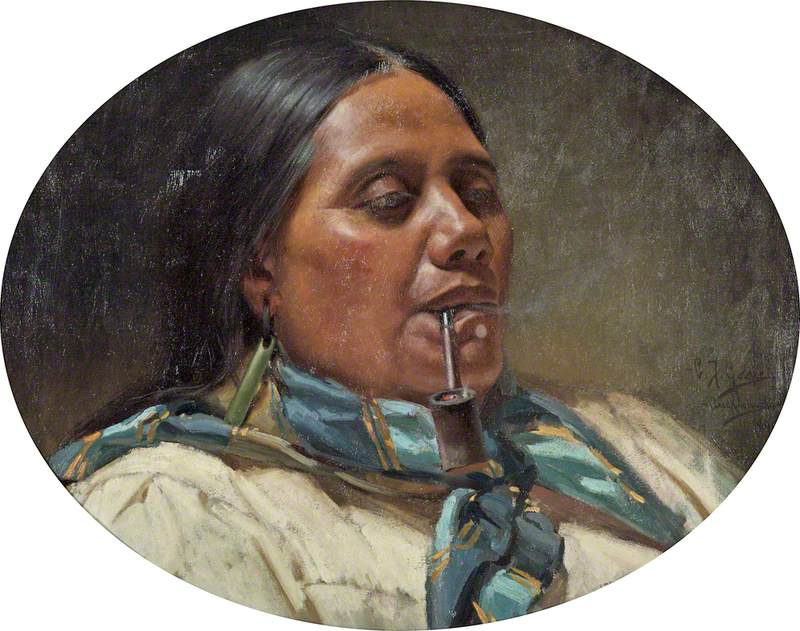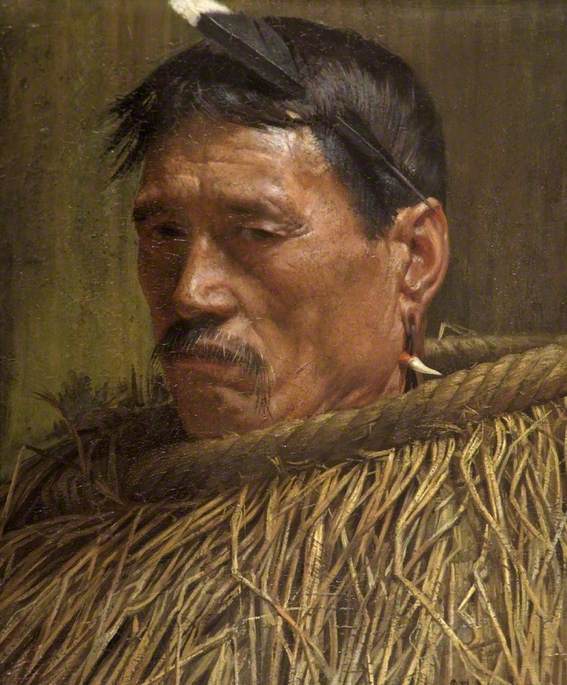New Zealander Charles Goldie, along with Gottfried Lindauer (1839-1929), helped define how the Maori people of New Zealand were seen by the outside world. After showing artistic talent at school and training under Louis John Steele (1842-1918) he went to the Académie Julian and visited art collections across Europe before returning home. He became devoted to Maori portraiture, developing friendships with his sitters and recording their culture. After his death, Goldie’s reputation suffered from a new focus on Modernism in New Zealand. He was also incorrectly perceived as a patronising imperialist, despite the Maori people always valuing his depictions of them, until the pioneering work of art historian Roger Blackley (1953-2019).
-
A Māori Chieftainess (Harata Rewiri Tarapata, 1831–1913)
A Māori Chieftainess (Harata Rewiri Tarapata, 1831–1913) 1906Goldie called his portraits of Maori sitters 'Ethnographs' and he concentrated on high status individuals such as Harata Rewiri Tarapata of the Ngāpuhi people. She is shown wearing various items which indicate her rank. The Hei Tiki pendant she is wearing is made from Greenstone (pounamu) which the Maori regard as a supernatural substance superior to anything else. She is also wearing a shark's tooth earring (mako) which is fixed with red sealing wax. The Maori associate sharks with strength and ferocity while red signifies sacredness and value. The real signifiers are her facial tattoos (moko) which are confined to her mouth and chin. Such tattoos went out of fashion in the 1920s but are now seeing a resurgence.
Charles Frederick Goldie (1870–1947)
Oil on canvas
H 61 x W 51 cm
Russell-Cotes Art Gallery & Museum
-
Te Aho Te Rangi Wharepu (1811–1910)
Te Aho Te Rangi Wharepu (1811–1910) 1907Te Aho Te Rangi Wharepu was a warrior of the Ngati Mahuta who posed regularly for Goldie from 1902 onwards. This powerful portrait shows him aged 97 and manages to convey a sense of both dignity and melancholic wisdom. He had survived defeat at the Battle of Rangiriri in 1863 when the Colonial Government and its Maori allies invaded the Waikato region of North Island. Like Harata Rewiri Tarapata, he is adorned with symbols of his rank and status: a fine flax tasseled cloak and a Hei Tiki. He is also wearing two Greenstone ear pendants (kuru). The Maori consider items made from Greenstone to increase in value as they are handed down the generations.
Charles Frederick Goldie (1870–1947)
Oil on canvas
H 73 x W 59.5 cm
Russell-Cotes Art Gallery & Museum
-
Allee Same Te Pakeha (A Good Joke) – Te Aho Te Rangi Wharepu (1811–1910) in European Costume
Allee Same Te Pakeha (A Good Joke) – Te Aho Te Rangi Wharepu (1811–1910) in European Costume 1905This is a contemporary print of an original portrait in oils held in the collection of the Dunedin Public Art Gallery, New Zealand. Goldie often made portraits of his sitters in European dress to contrast with the ones of them in traditional garb. One of Goldie's favourite subjects, Te Aho Te Rani Warepu was a renowned canoe carver, tattooist and authority on Maori history and mythology. Full facial tattoos like his, were reserved only for male leaders such as himself. Their intricate designs were intended to visually and spiritually communicate the wearer's personality, genealogy, rank and warrior prowess. They were built up over many years from an intricate combination of spirals (koru) and curving lines.
Charles Frederick Goldie (1870–1947)
Chromolithograph on paper
H 38.5 x W 30.5 cm
Russell-Cotes Art Gallery & Museum
-
Kai Paipa or Māori Woman (Katerina Nikorima)
Kai Paipa or Māori Woman (Katerina Nikorima) 1903Lady Martin (1817-1884), the wife of Sir William Martin (1807-1880) the first Chief Justice of New Zealand, took Katerina Nikorima as her ward. She was educated in England and given all the accomplishments expected of an upper class young woman. She spoke several languages, played the piano and used her fine contralto voice to perform at charity concerts. Katerina married a chief of the Ngati Maru and eventually withdrew from European society in favour of the Maori community. Sadly we have not been able to discover her dates but she sat for Goldie at least three times. The Maori encountered tobacco via European whalers and the women smoked as much as the men.
Charles Frederick Goldie (1870–1947)
Oil on canvas
H 37.5 x W 46.5 cm
Russell-Cotes Art Gallery & Museum
-
Suspicion: A Māori Chief
Suspicion: A Māori Chief 1906Although respectful of the Maori, Goldie's portraits were intended for the art market. As well as painting Maori leaders and elders, he also produced paintings like this. Here the sitter is expressing a specific emotion for the appreciation of a European viewer. This sitter is unknown but he wears a shark's tooth earring and a Huia bird feather. The now-extinct Huia was a songbird that the Maori regarded as most sacred. All our works by Goldie were presented to our Founders by Mrs Sarah Struben Beulah Burton, daughter of W. Hobson of Auckland, New Zealand, who bought them directly from Goldie. Our thanks to RCAGM volunteer Charlotte Scott-Beveridge for her research assistance.
Charles Frederick Goldie (1870–1947)
Oil on board
H 28 x W 22.6 cm
Russell-Cotes Art Gallery & Museum
